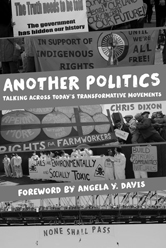BOOK REVIEW: Another Politics: Talking Across Today’s Transformative Movements

 Another Politics: Talking Across Today’s Transformative Movements
Another Politics: Talking Across Today’s Transformative Movements
by Chris Dixon
University of California Press, 2014
Reviewed by Carwil Bjork-James
Over the past two decades, a certain kind of radical politics has surfaced and resurfaced, most recently within the whirlwind of activism that made up the Occupy movement. As the movement spread and encampments grew, occupiers sought to deepen their critiques and build democracy amongst themselves. Participants looked beyond a single demand to a systemic challenge, through which “all our grievances are connected” — confronting a multiplicity of forms of power, while insisting that the very process of confrontation must be rethought as well. Chris Dixon has assembled a number of self-conscious practitioners of this critical, bottom-up, and egalitarian politics, which he calls the anti-authoritarian current, in a remarkable and many-voiced synthesis of their praxis.
Another Politics is both an introduction to this stream of radical politics and an attempt to clearly articulate the issues that it is still grappling with. It honestly portrays the intellectual and strategic heritage of this current, while bringing the reader into the middle of present debates and challenges. Through clear concise writing, dozens of interviews, and a carefully designed structure, Dixon acquaints the reader with the movement’s critique (described as “the four anti’s”) and its attempts to prefigure a revolutionary shift in how people make decisions, work together, and relate to one another. While acknowledging capital, imperial war, racism, and patriarchy as interlocking systems of power has become commonplace among grassroots activists, anti-authoritarians also turn a critical eye to a variety of top-down structures: the state, political parties, hierarchical organizations—anything that constitutes holding “power over” another. This second critique distances them from many conventional forms of social change, even on the left. Far from becoming isolated critics, anti-authoritarians have adopted and updated alternative ways of organizing, including consensus process, personal anti-oppression work, and organizing driven by those “most affected” by an issue. Clearly, the current has created its own vocabulary for thinking through power in both society and movements. Fortunately, newcomers can find an accessible primer to this language in these pages.
While political labels like “anarchist” or “[prison] abolitionists” tend to emphasize a single political lineage, many of these radicals are inspired by multiple histories of struggle and bring together practices of organizing from a variety of radical movements. Dixon’s first chapter introduces and narrates this plural heritage, including anarchist labor organizers, pacifists and practitioners of civil disobedience, the Civil Rights and Black Freedom movement, women’s liberation and Black feminism, direct action environmentalism, and queer movements from Stonewall to ACT UP. It also describes places beyond North America where anti-authoritarians look to for inspiration and critical ideas. Neither a laundry list nor a historical narrative, Dixon’s review illustrates the ideas, methods of organizing, and tactics that each of these movements introduced, absorbed into collective wisdom about thinking through and doing politics.
The anti-authoritarian current has a long history but a small core membership. Unlike some other radical perspectives that devote most of their efforts to creating mass organizations, anti-authoritarians have become most visible through waves of mobilization, notably the antiglobalization movement at the turn of the century and the Occupy movement, more recently. These struggles were open spaces in which tens of thousands participated, but anti-authoritarian politics, priorities, tactics, and forms of organizing were critical to their structure. Dixon and his interviewees look beyond these highly visible periods to the steady work of grassroots organizing. In this arena as well, he argues, anti-authoritarians can and have contributed to a rethinking of how to do politics. The book explores their experiences in shaping organizations opposing the prison- industrial complex, combatting sexual violence in communities of color, resisting deportations, and challenging poverty.
“Activism” among universal constituencies (the “99%,” for example) and “organizing” among marginalized communities exist in a strategic and practical tension for many participants in the current. How do we make our activism accountable to those most affected? How do we balance excitement and sustainable action? Who, if anyone, must lead the revolution? Around this and other tensions, Dixon urges a both-and (rather than either-or) response, and models a process of patient listening and constructive aggregation of disparate views. The discussion is broad-ranging, serious, and unresolved, as it remains in the movement at large. Dixon offers plenty of suggestions, but sticks to an open-ended discussion among active participants in his latter chapters. All in all, it is a smart, synthetic, and vital account of what anti-authoritarians believe is wrong in the world, and how they strive to challenge and overcome it.
